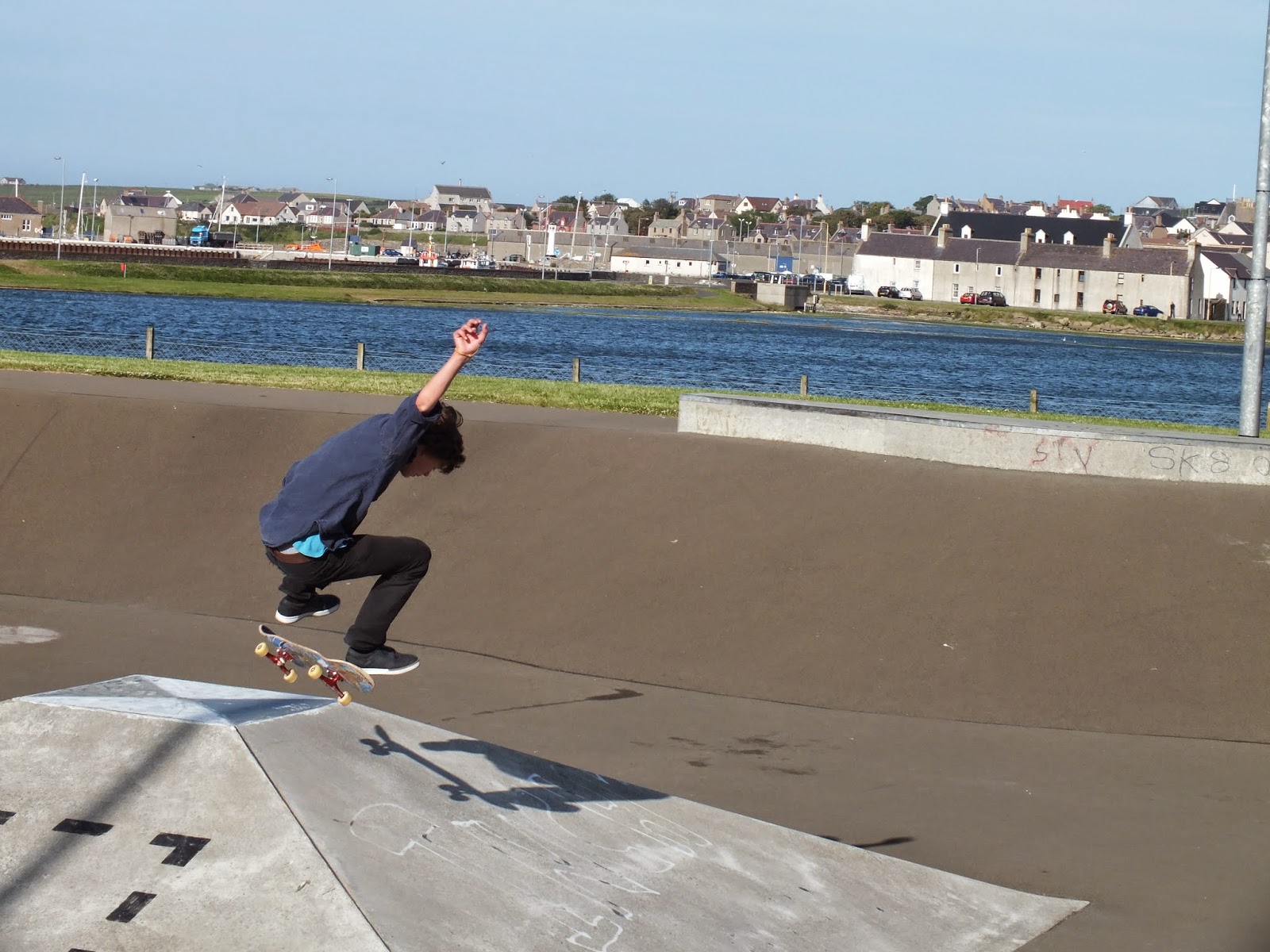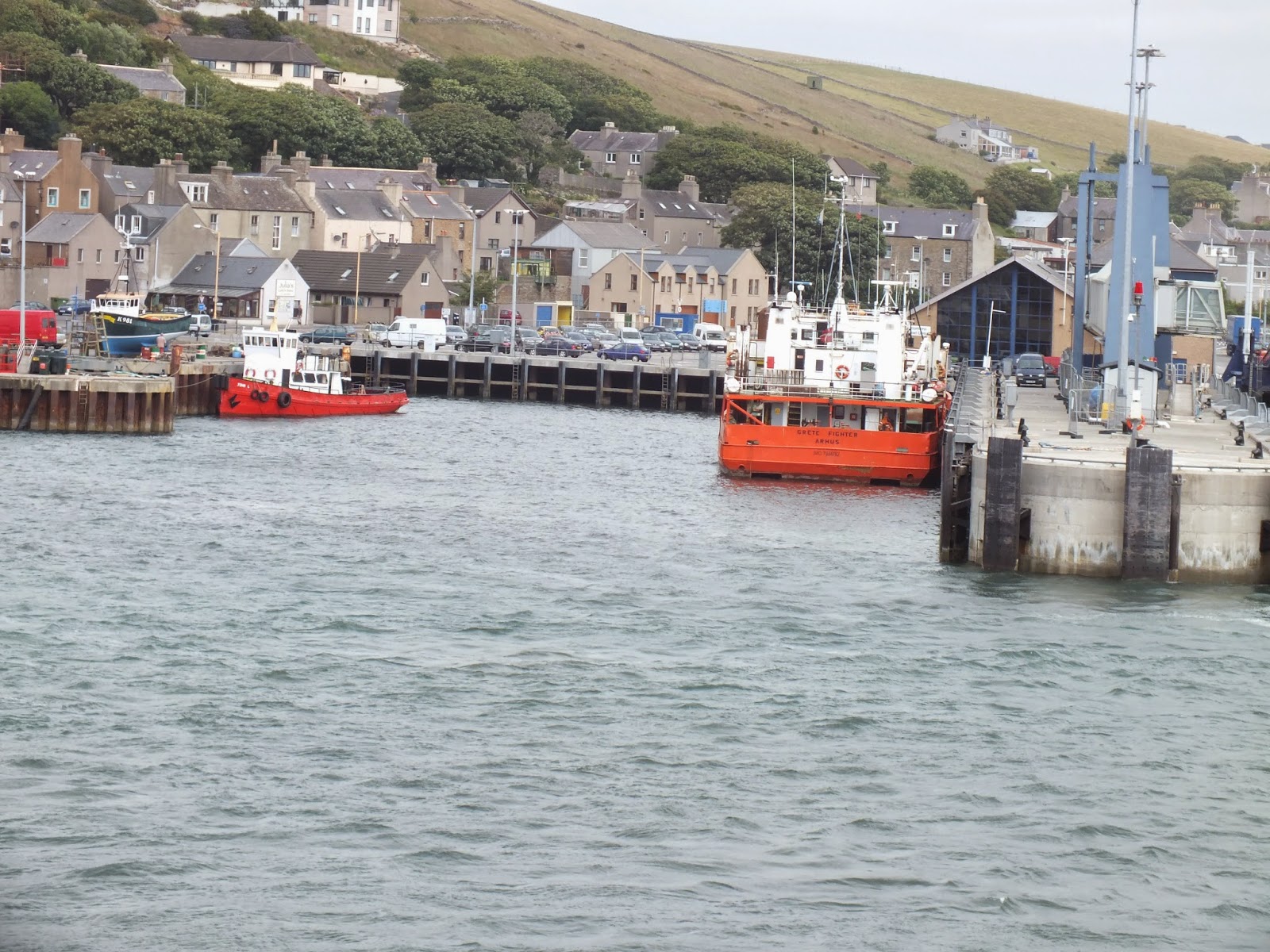 |
| Brough of Birsay, Orkney (low tide) |
Maeshowe had been a nice respite from the wind and now we are ready to head up to the northwest tip of the island to explore the Brough of Birsay, a small island only accessible during low tide. We have timed our adventure just right. The sun has finally come out making the wind more tolerable. My vantage point from the car allows me to regard the effects of the wind without my hair whipping into my eyes. Orkney is largely agricultural and the grain crops undulate in the fields fiercely like there is a small army underneath charging toward the end of the fields Forming a large moving patchwork blanket, the fields seems almost like a single living creature if you stand still, unfocus your eyes and stare at the horizon long enough.
 |
| Path to Brough of Birsay, Orkney |
Finding the Brough of Birsay, we trek across the concrete path toward the island. Thought to have been first settled by Christian missionaries in the fifth century AD, the island became a Pictish stronghold in the 9th century before being completely taken over by the Vikings. The sight itself is archelogically rich for this reason. Although the Norsemen built their dwellings on top of and around what remained of Pictish foundations, the artifacts found show that the Picts had operated a small forge on the island. The most important find occured in 1935 with the discovery of the Pictish Symbol Stone, the original which now resides in a museum in Edinburgh.
 |
| Viking and Pictish ruins, Brough of Birsay, Orkney |
http://www.orkneyjar.com/history/broughofbirsay/
The island itself resembles a large bowl that has been upended. There are cliffs of varying sizes, and a lighthouse at the top of the island. There are no trees and the grass on the island is almost knee level and the tips are an aubergine color. The frequent wind has tangled the tips of the grasses together into different shapes and patterns that are interesting.
 |
| Sea birds and cliffs, Brough of Birsay, Orkney |
 |
| Cliffs, Brough of Birsay, Orkney |
After exploring the ruins we set off up the hill an find the cliffs on the northern side of the island. Not wanting to watch my children peer over the edge of the cliff, I tell my family that I am going to the top of the hill. Cresting the hill I linger and enjoy the view near the lighthouse. Small caves and other depressions no doubt created by wind and water permeate this side of the island and I explore some of these depressions before making my way down the south side of the island. I must have taken a long time to do all this. At one time I wait for Sam and the boys to catch up with me but they never came. When I finally head back to the ruins I see my oldest son Will charging up the middle of the hill toward the lighthouse. Waving at him he sees me and throws up his hands in a relief gesture. Apparently, Sam and the boys had walked back to the parking lot, even driven to a nearby castle ruin looking for me. They had really been worried that I had fallen or something. Regrouping, we make a pact to not separate from one another again as I have the only working cell phone of the four of us.
 |
| Brough of Birsay cliffs, Orkney |
Relieved, we head to the car to visit our last site, Broch of Gurness, over on the east side of the island. Driving through the bald undulating landscape with the windows cracked we experience the smells of crops, barnyard, and fresh windwhipped air. We pass a small loch (Loch Swannay) that is the darkest inkiest shade of blue, the contrast against the lanscape is stunning. Water whether it be in a loch, bay, river, ocean or even a small puddle is capable of registering so many different shades of blue, green, gray and even pink, orange and white. I drift off on a tangent thinking of the miraculous properties of water when we turn into the car park for Broch of Gurness.
Arriving at Broch of Gurness, we are informed that the site is closed. My search and rescue had taken up a fair amount of time. The kindly Orcadian gentleman operating the site allows us to go ahead and have a look around anyway. All around Scotland we have witnessed this sort of kindness. We thank him and have a quick survey. Broch of Gurness is situated on Eynhallow Sound with views of other islands to the north. A "broch" is a uniquely Scottish structure, round and of dry stone construction. There are many examples of brochs throughout Scotland in various stages of decay and/or preservation. It is thought they may have served a military purpose much like a castle tower or they could have simply been dwellings. The brochs here are thought to have been built between 200-100 BC. As with other ancient sites on Orkney it to has the Pictish/Viking past. The story of the rediscovery of this site is interesting (see link below.)
http://www.orkneyjar.com/history/brochs/gurness/
 |
| Broch of Gurness, Orkney |
Walking to the car I realize what a glorious day it has been even with all the drama on Brough of Birsay. We will head towards Kirkwall to relax and find some dinner.
 |
| Limpets, Brough of Birsay, Orkney |












































